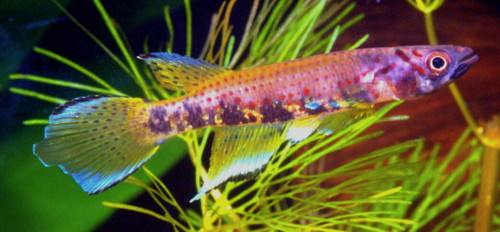

E.ansorgii Gamba, Gabon. Photo courtesy of Ed Pürzl.
| Meaning of Name |
After Dr. W.J.Ansorge who originally collected the species. |
|||||
| First Description |
Boulenger G.A. 1911. Descriptions of new African Cyprinodont fishes. Annals & Magazine of Natural History (8) 8 (44): p 262-263. |
|||||
| Size |
8 cm. |
|||||
| Meristics |
|
|||||
| Karyotype |
n = 24, A = 25 (Radda & Pürzl 1981) |
|||||
| Sub-Genus |
Epiplatys |
|||||
| Group |
multifasciatus |
|||||
| Synonyms |
|
|||||
Populations
|
Masana - GJS 00 / 2 - Collected in 2000. Masana was small river 5-6 metres wide & 0·5 metres deep. Lots of fallen leaves around edges. Very red fins & a blue body covered with red dots. 1 female & 3 males survived the trip back to Denmark. Breeding was easy & the fish was distributed.
|
|||||
| Type Locality |
Ogowe, in the Masoma River which flows into Lake Agemwe at Umpokoya. Collected by Dr.W.J.Ansorge. |
|||||
| Distribution |
From the lower Ogowe River system of western Gabon in small tributaries to the lower Zaire River drainage system in western Zaire. http://homepage.uibk.ac.at/homepage/c102/c102mr/epiplaty/ansorg.htm |
|||||
| Habitat |
Coastal lowland rainforest in small rivers & brooks.
Biotope of E.ansorgii
south of Lambarené, Gabon. |
|||||
| Distinguishing Characteristics | Dark stripe on the outer margins of unpaired fins. | |||||
| Colour/Pattern Variability | ||||||
| History |
In 1911 Boulenger described this species from 2 large individuals from the Masoma River which flowed into Lake Agemwe at Umpokoya, Gabon. Boulenger gives the following collector / location in his 1915 Catalogue.
In 1929 Holly reported them in southwest Cameroon from mountain brooks in the Bakoko district. These may have been E.sexfasciatus which are endemic to this area. Pellegrin, in 1930 reported E.ansorgii from the Sangha - Congo drainage. Lambert in 1961 saw this material. Scheel considered that these may have represented E.multifasciatus. Pellegrin ( 1930 ) also reported them from Man, Ivory Coast. This was dismissed due to being well outside the geographical distribution for the species. A import by BKA Species Import in August/September 1974 was identified & distributed as ansorgii. This identification was made in error & this sp. was most likely macrostigma, now regarded as a synonym of singa. This was probably the first import of this sp. into the UK. History of the synonym E.berkenkampi Neumann 1978. First description: Neumann W. Aquarien Terrarien
(DDR). 25 (4): 125-127, 1978. |
|||||
| Breeding Notes |
Regarded as a prolific species. Water incubation takes 12-16 days. Sexual maturity takes about 7-8 months. Adrian Burge sent me details of how he spawns the population from Massana GJS 00/2. "The species are kept and spawned in rainwater
collected from the house roof. The pH is around 7.2, the hardness has
never been checked but it must be fairly low. |
|||||
| Diameter of Egg | 1·7 mm. | |||||
| Remarks |